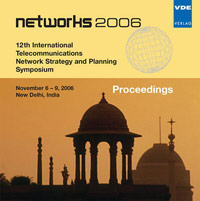The Future of Transport – Evolution of Network Elements for Packet-oriented Transmission Backbone Networks
Konferenz: networks 2006 - 12th International Telecommunications Network Strategy and Planning - Symposium
06.11.2006 - 09.11.2006 in New Delhi, India
Tagungsband: networks 2006
Seiten: 6Sprache: EnglischTyp: PDF
Persönliche VDE-Mitglieder erhalten auf diesen Artikel 10% Rabatt
Autoren:
Frohberg, Wolfgang (ALCATEL Optical Networks, Germany)
Inhalt:
The growth of data traffic caused network operators to build backbone overlay networks. Most of them are IP router networks. Routers are interconnected by fibres or WDM links, i.e. there are limitations in flexibility and the fulfilment of other requirements normally associated with a transmission network. However, for any wide area network a transmission layer is needed for efficient networking. Investigations of the IP backbone of a European incumbent operator have shown, that overall network cost can be lowered by such transmission layer. Today, transmission is based on TDM. The growth of packet based data traffic justifies the development of a packet based transmission technology. A packet transmission layer can fulfil the same transport specific requirements as a TDM transmission layer. The evolution of network elements toward packet transmission in backbone networks will happen in three steps: (1) enhancement of TDM nodes with data functionality; (2) Agnostic Nodes for a transition period; (3) Pure Packet Transmission Nodes. Assuming a further exponential data traffic growth, in 5 to 8 years from now packet transmission will be the dominating technology. To implement this, a data plane, a control plane, a management plane and essential mechanisms for Operation and Maintenance (OAM) as well as for resilience have yet to be standardized and developed. This currently is one major topic in standardization of Transport Ethernet and T-MPLS. For a persistent control plane in multi layer networks Generalized MPLS (GMPLS) is a promising approach. Whenever links in the packet network can be found that request transmission capacity of multiple wavelengths, the introduction of another “bulk transport” layer makes sense.


